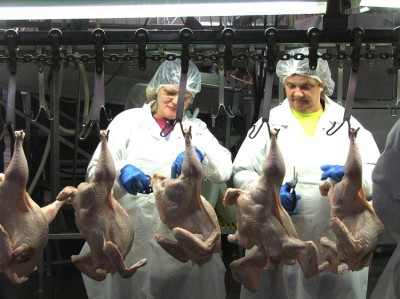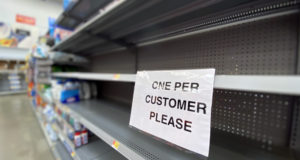 The United States Department of Agriculture (USDA) is increasing the chances of poultry contamination by speeding up its inspection process and poultry production lines.
The United States Department of Agriculture (USDA) is increasing the chances of poultry contamination by speeding up its inspection process and poultry production lines.
That’s the opinion of a veteran USDA Food Safety and Inspection Service (FSIS) inspector who worked in poultry processing plants for years.
The amount of contaminated chicken, duck and turkey reaching supermarket shelves will increase because the FSIS intends to double the speed at which poultry is processed, Alvin Sewell believes. Sewell opposes the plan because it’ll make it harder for inspectors to spot contaminated birds or problems that lead to contamination.
“Even with massive poultry recalls, foodborne illness outbreaks, and compromises in worker safety, FSIS intends to allow further increases in line speeds,” Sewell wrote in a Food Safety News editorial. “The 175 birds-per-minute proposed line speed more than doubles the current standard of 70 birds per minute under Streamlined Inspection System regulations.”
Higher Speeds Equal Dirty Birds?
The old regulations are being replaced by a new protocol called the Hazard Analysis Critical Control Points Inspection Models Project or HIMP. HIMP effectively means the end of federal inspection of most poultry processed in the United States, Off the Grid News previously reported.
Packed full of information on some of the key aspects of raising chickens.
“I immediately learned that the remedy for high rates of contamination was to decrease the line speed,” Sewell wrote of his early days as a FSIS inspector. He noted that workers on higher speed lines are more likely to make mistakes that will increase the likelihood of contamination.
To make matters worse, the HIMP plan will put the inspection of poultry in the hands of slaughterhouse employees, not USDA personnel. Decisions will be made by workers who could lose their jobs if they don’t keep production levels high.
“Unlike FSIS inspectors, plant ‘sorters’ in the HIMP pilot plants are under pressure from their production supervisors to do whatever it takes to maintain the maximum rate of production,” Sewell wrote.
Policy Already To Blame For Contamination?
The HIMP changes could be responsible for the high levels of salmonella bacteria that Consumer Reports found in store-bought chicken in December, Sewell noted. Off the Grid News reported that 97 percent of the chicken breasts the consumer group tested were found to be contaminated.
The contamination sometimes occurs because poultry that contains fecal matter is not removed from the production lines. Instead, contaminated carcasses are treated with chemicals and processed.
“In other words, fecal contamination is spread and theoretically sanitized in the anti-microbial intervention process,” Sewell noted. He said the process was called “online reprocessing.”
Sewell concluded:
It is my opinion that historic increases in line speed have had a significant negative impact on the FSIS inspection process. It is also my assertion that the HIMP will significantly worsen problems of consumer and plant worker safety. There comes a time to introduce pragmatism into the discussion of the point where profitability and safety cross.
While I fully accept the reality of the industry’s need to cut costs and make processing more profitable, it must be balanced within the scope of consumer safety and product viability. Drastic increases in line speeds will enhance neither.
Those who like chicken, turkey and duck have yet another reason to raise their own poultry.
Sign up for Off The Grid News’ weekly email and stay informed about the issues important to you
 Off The Grid News Better Ideas For Off The Grid Living
Off The Grid News Better Ideas For Off The Grid Living



